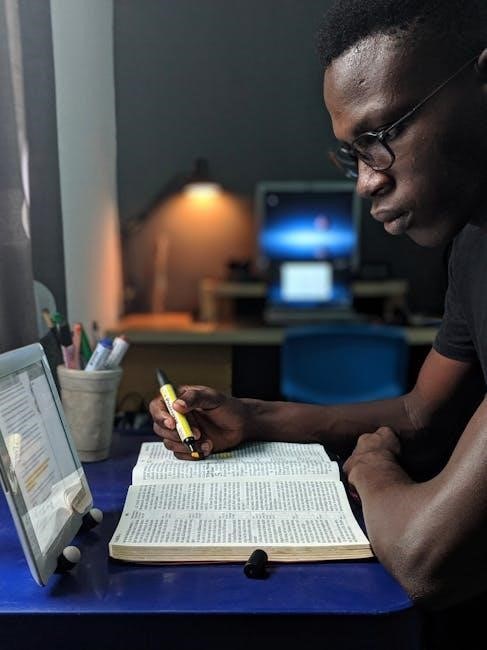Discover the art of understanding others through body language, facial expressions, and verbal cues. Learn to decode hidden emotions, detect lies, and build deeper connections effortlessly in everyday interactions.
Understanding the Basics of Human Behavior
Human behavior is shaped by a combination of verbal and nonverbal cues, offering insights into emotions, intentions, and motivations. Nonverbal signals, such as body language and facial expressions, often reveal more than words alone. By studying these cues, one can decode underlying emotions and intentions, even when they contradict verbal statements. Understanding human behavior involves recognizing patterns in body language, such as posture, eye contact, and hand gestures, which can indicate confidence, nervousness, or deception. Additionally, contextual factors like cultural background and personal experiences influence behavior, making it essential to consider these elements when interpreting signals. Mastering these basics enhances emotional intelligence, fostering deeper connections and improving communication in both personal and professional settings. This foundation is crucial for effectively “reading” people and navigating social interactions with confidence and accuracy.
Why Reading People is Essential in Personal and Professional Life
Reading people is a vital skill that enhances both personal and professional relationships by fostering deeper connections and understanding. In personal life, understanding others’ emotions and intentions can improve communication, reduce conflicts, and strengthen bonds with family and friends. Professionally, this skill aids in building trust, negotiating effectively, and leading teams. By deciphering nonverbal cues, individuals can anticipate needs, address concerns, and create harmonious work environments. In sales and customer service, reading people helps tailor approaches to client preferences, boosting satisfaction and loyalty. Overall, mastering the ability to read people fosters empathy, collaboration, and success in all areas of life, making it an invaluable tool for personal and professional growth.
Overview of the Book “Read People Like a Book”
Read People Like a Book by Patrick King offers a comprehensive guide to understanding human behavior, emotions, and intentions through body language, facial expressions, and verbal cues. Unlike traditional books on body language, this text delves deeper into human psychology, providing insights into motivations, personality types, and lie detection. It equips readers with practical techniques to decode nonverbal signals, enhance emotional intelligence, and improve communication skills. The book is designed to help individuals connect effortlessly with others, fostering deeper and more authentic relationships in both personal and professional settings. By mastering the art of reading people, readers can navigate social situations with confidence and build stronger connections. This insightful guide is essential for anyone seeking to understand human nature and improve their interpersonal skills.

Understanding Body Language
Understanding body language is key to decoding hidden emotions and intentions. Learn how nonverbal cues like posture, gestures, and eye contact reveal inner thoughts and feelings instantly.
The Role of Nonverbal Cues in Communication
Nonverbal cues play a vital role in communication, often conveying more information than spoken words. Facial expressions, body posture, and hand gestures reveal emotions and intentions, helping to build trust and rapport. These signals can reinforce verbal messages or contradict them, highlighting their importance in understanding others. By recognizing nonverbal cues, individuals can navigate social interactions more effectively, fostering deeper connections and avoiding misunderstandings. This skill is particularly valuable in professional settings, where subtle cues can greatly impact negotiations and relationships. Understanding nonverbal communication enhances emotional intelligence, allowing individuals to interpret and respond appropriately to unspoken messages. This chapter explores how to decode these cues, providing practical insights to improve communication skills and interpersonal dynamics.
Conscious and Subconscious Body Language Signals
Body language is a powerful tool that conveys messages both consciously and subconsciously. Conscious signals, like deliberate hand gestures or a planned smile, are intentional and often used to emphasize points or control interactions. Subconscious signals, however, reveal involuntary emotions, such as crossed arms indicating defensiveness or avoiding eye contact signaling discomfort. Understanding these cues is essential for interpreting true intentions. While conscious signals can be manipulated, subconscious ones often betray a person’s genuine feelings. Recognizing both types allows for a deeper understanding of others, helping to navigate social situations more effectively. This chapter explores how to distinguish between these signals, providing insights into the hidden language of the body and its impact on communication and relationships.
How Body Language Reveals Emotions and Intentions
Body language is a window into a person’s emotions and intentions, often revealing more than words alone. Posture, facial expressions, and eye contact can signal confidence, nervousness, or even deceit. For instance, leaning forward may indicate interest, while crossed arms could suggest defensiveness. Micro-expressions, fleeting facial cues, often expose true emotions before they are consciously hidden. Additionally, gestures like hand movements can emphasize points or betray nervousness. The alignment of verbal and nonverbal signals is crucial; inconsistency may indicate dishonesty. Understanding these cues allows for better comprehension of others’ emotional states and hidden agendas. This chapter delves into the subtle ways body language communicates feelings and intentions, providing tools to interpret these signals accurately in various social and professional contexts.

Facial Expressions and Emotions
Facial expressions are powerful indicators of emotions, often revealing true feelings before words can. Universal expressions like happiness, sadness, and anger transcend cultures, while micro-expressions provide glimpses into hidden emotions.
Universal Facial Expressions Across Cultures
Facial expressions are a universal language, transcending cultural boundaries. Research shows that emotions like happiness, sadness, anger, fear, surprise, and disgust are expressed similarly across cultures. These universal signals, often innate, allow people to recognize emotions globally. For instance, a smile is widely recognized as a sign of happiness, while a furrowed brow indicates concern. This consistency enables effective nonverbal communication, even in the absence of shared language. Understanding these universal expressions is key to reading people accurately, as they provide immediate insights into emotions and intentions. By recognizing these common cues, you can better connect with others, fostering deeper relationships and improving communication. This universal aspect of facial expressions is a cornerstone of emotional intelligence, making it easier to navigate diverse social interactions with confidence and empathy.
Micro-Expressions: The Key to Hidden Emotions
Micro-expressions are fleeting facial cues that reveal true emotions, often subconscious and hidden beneath surface-level expressions. Lasting less than a second, these involuntary flashes can contradict verbal statements, exposing genuine feelings like fear, guilt, or joy. They are closely tied to specific emotions and are nearly impossible to fake, making them a powerful tool for understanding others. Researchers like Paul Ekman have categorized these expressions, linking them to universal emotions. By mastering the ability to spot micro-expressions, you can uncover hidden truths, detect lies, and gain deeper insight into others’ intentions. This skill is invaluable in both personal and professional relationships, allowing you to navigate interactions with heightened emotional intelligence and empathy. Recognizing micro-expressions bridges the gap between what people say and what they truly feel, enhancing your ability to connect on a deeper level.

Detecting Lies and Deception
Detecting lies involves recognizing inconsistencies in body language, verbal cues, and micro-expressions. Context is crucial, as subtle changes can reveal hidden truths and deceptive intentions effectively.

Common Signs of Dishonesty in Body Language
Identifying dishonesty often involves noticing inconsistencies in body language. Common signs include avoiding direct eye contact, fidgeting, or crossing arms, which may indicate discomfort or hiding something. Micro-expressions, fleeting facial cues, can reveal true emotions like guilt or fear. Additionally, people may display nervous behaviors such as tapping feet or hands, or touching their face excessively. Context plays a significant role, as these signals don’t always confirm dishonesty but can suggest it. Understanding these nonverbal cues helps in assessing trustworthiness and detecting potential deception effectively.
- Avoiding eye contact or inconsistent gaze.
- Fidgeting or restless body movements.
- Micro-expressions revealing hidden emotions.
- Nervous gestures like touching the face or hair.
These signs, when contextualized, can provide insights into potential dishonesty.
How Context Affects Lie Detection
Context plays a significant role in accurately interpreting behaviors associated with dishonesty. Cultural differences, personal stress, and the environment can influence how nonverbal cues are expressed and perceived. For instance, behaviors like avoiding eye contact or fidgeting may indicate nervousness rather than deceit, depending on the situation. Relationship dynamics also affect interpretations, as familiarity can alter comfort levels and body language. Additionally, the setting and past experiences can shape perceptions, potentially leading to misjudgments. Understanding the broader context is essential to avoid misinterpreting signals and to improve the accuracy of lie detection. By considering these factors, one can better assess the sincerity of others in various social interactions.
Practical Techniques to Spot Lies in Everyday Conversations
Mastering the art of detecting lies involves a combination of observation and critical thinking. Pay attention to inconsistencies in a person’s words and body language, as these often reveal dishonesty. For instance, if someone avoids eye contact or displays micro-expressions of fear or guilt, it may indicate deception. Additionally, encourage openness by asking open-ended questions, which can uncover hidden truths. Listen for contradictions in their stories and note if they avoid direct answers. Furthermore, observe physical cues like fidgeting or crossed arms, which can signal discomfort or dishonesty. By practicing these techniques, you can enhance your ability to spot lies and navigate conversations with greater confidence and insight. Remember, context is key, and avoiding assumptions ensures more accurate assessments of others’ sincerity.

Understanding Human Psychology
Explore the science behind human motivations, emotions, and behaviors. Learn how psychological principles influence interactions, helping you decode intentions and connect deeply with others in personal and professional settings.
The Science Behind Human Motivations
Understanding human motivations is key to reading people effectively. Research shows that motivations are driven by emotional needs, desires, and unconscious patterns. These factors influence behavior, often revealing underlying intentions. By recognizing these psychological drivers, you can better interpret actions and decisions, fostering deeper connections. This knowledge helps in predicting reactions and aligning communication strategies, making interactions more meaningful and effective in both personal and professional contexts.

Personality Types and Their Impact on Behavior
Personality types significantly influence behavior, shaping how individuals interact with the world. Understanding these types helps in predicting reactions and adapting communication strategies. For instance, introverts may prefer quieter environments, while extroverts thrive in social settings. Personality traits like openness, conscientiousness, and agreeableness also play a role in decision-making and emotional responses. Recognizing these differences allows for more effective connections, whether in personal relationships or professional collaborations. By identifying dominant personality traits, you can tailor your approach to align with their natural tendencies, fostering harmony and understanding in various interactions.
How to Use Psychology to Connect with People
Psychology offers powerful tools to foster meaningful connections with others. By understanding emotional intelligence, empathy, and behavioral patterns, you can adapt your interactions to resonate deeply; Active listening and mirroring techniques help build rapport, while recognizing nonverbal cues enhances communication. Applying psychological principles like reciprocity and genuine interest encourages trust and openness. Understanding motivations and needs allows you to tailor your approach, making others feel valued. These strategies, rooted in human behavior insights, empower you to navigate social dynamics effortlessly and form authentic relationships in both personal and professional settings.

Personality Types and Traits
Understanding personality types and traits reveals how individuals think, behave, and interact. Recognizing these patterns helps tailor communication and build stronger connections with others effectively.
Identifying Different Personality Types
Understanding personality types is key to decoding human behavior. Common types include introverts, extroverts, thinkers, and feelers, each with distinct traits. Introverts may prefer solitude, while extroverts thrive in social settings. Thinkers often prioritize logic, whereas feelers focus on emotions. Observing how individuals respond to stress, make decisions, and interact with others helps identify their personality type. Recognizing these patterns enhances communication and empathy, allowing for more tailored interactions. While personalities are unique, categorizing them simplifies understanding. Practical techniques, like active listening and observation, aid in accurately identifying types. This knowledge fosters deeper connections and improves relationships, both personally and professionally, by aligning interactions with individual preferences and behaviors. Mastering this skill enables effortless navigation of social dynamics and more meaningful communication.
Understanding Motivations Behind Behavior
Behavior is driven by underlying motivations, often rooted in desires, fears, or goals. Recognizing these drivers is essential for understanding why people act a certain way. For instance, a person’s need for control may stem from past insecurities, influencing their decisions and interactions. Motivations can be intrinsic, like personal satisfaction, or extrinsic, such as social approval. Observing patterns in behavior helps uncover these underlying forces. By understanding what drives others, you can tailor your approach to align with their needs, fostering cooperation and trust. This insight also reveals hidden intentions, enabling you to navigate situations more effectively. Motivations are not always explicit, but they shape actions and reactions, making them a crucial aspect of reading people like a book. This knowledge enhances empathy and communication, leading to stronger connections and more successful interactions.

The Power of Eye Contact
Eye contact reveals confidence, trust, and attentiveness. It conveys emotions and intentions subtly, fostering deeper connections. Mastering its use enhances communication and builds rapport effortlessly in interactions.
Types of Eye Contact and Their Meanings
Eye contact is a powerful nonverbal cue with various meanings. Direct eye contact signifies confidence, honesty, and interest, while avoiding it may indicate nervousness or dishonesty. Prolonged eye contact can express dominance or aggression, whereas fleeting glances might suggest shyness or lack of confidence. In romantic contexts, soft, warm eye contact conveys attraction and connection. Understanding these nuances helps in interpreting emotions and intentions accurately, allowing for more effective communication and relationship building. By recognizing different types of eye contact, one can navigate social interactions with greater empathy and awareness, fostering deeper connections and trust;

Enhancing Emotional Intelligence
Emotional intelligence is key to understanding others’ feelings and improving interactions. Practical techniques from “Read People Like a Book” help recognize nonverbal cues and adapt communication for deeper connections and personal growth.
How to Improve Communication Skills
Improving communication skills involves active listening, empathy, and awareness of nonverbal cues. By understanding body language, facial expressions, and tone, you can decode others’ emotions and intentions accurately. This skill fosters deeper connections and more meaningful interactions; Patrick King’s insights in “Read People Like a Book” emphasize the importance of aligning verbal and nonverbal messages to avoid misunderstandings. Additionally, recognizing micro-expressions and subtle behavioral changes can enhance your ability to navigate social situations effectively. By mastering these techniques, you can become a more attentive and persuasive communicator, fostering trust and rapport in both personal and professional relationships. This comprehensive guide provides practical strategies to refine your communication abilities and connect effortlessly with others.
Mastery of reading people involves understanding intentions, emotions, and motivations. By applying these skills, you can foster deeper connections, enhance relationships, and achieve personal and professional growth effectively.
Mastering the Art of Reading People
Mastering the art of reading people involves understanding their body language, facial expressions, and verbal cues to decode their emotions and intentions. This skill allows you to connect deeply, build trust, and navigate social and professional situations with confidence. By learning to recognize subconscious signals, such as micro-expressions and contextual behaviors, you can uncover hidden truths and make informed decisions. The ability to read people like a book also enhances emotional intelligence, enabling you to empathize and communicate more effectively. Practical techniques, like observing eye contact and identifying personality types, provide a comprehensive approach to understanding human behavior. Over time, this skill becomes second nature, helping you forge authentic relationships and achieve personal and professional success. Continuous learning and refinement of these skills are key to truly mastering the art of reading people.
Applying the Skills in Real-Life Scenarios
Applying the skills learned from “Read People Like a Book” in real-life scenarios can significantly enhance personal and professional interactions. In workplace settings, understanding a colleague’s body language can help navigate conflicts or negotiate deals effectively. In social situations, recognizing emotional cues allows for deeper connections and empathy. The techniques outlined, such as decoding micro-expressions and interpreting eye contact, prove invaluable in everyday conversations. For instance, detecting subtle signs of dishonesty can prevent misunderstandings, while identifying personality traits helps tailor communication strategies. These practical applications not only improve relationships but also foster a more harmonious and productive environment. By integrating these insights into daily life, individuals can become more perceptive and influential, leading to greater success and fulfillment in both personal and professional realms.